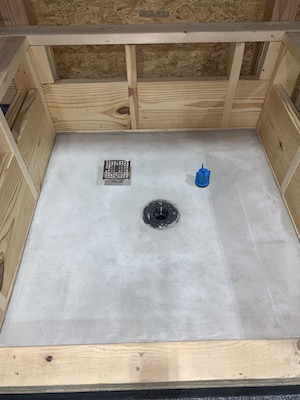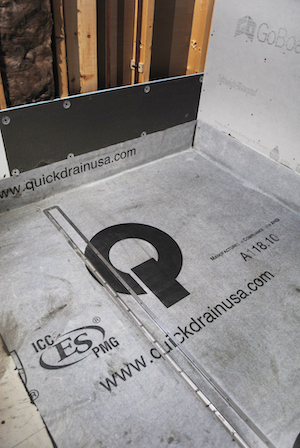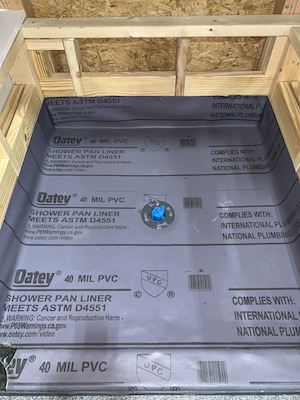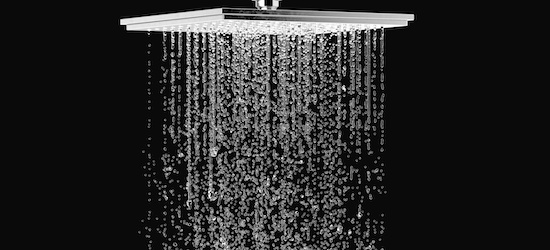By Matt Valore, Tile & Flooring Channel Sales, QuickDrain USA
When it comes to shower installation and waterproofing, taking shortcuts can lead to disastrous results, especially when a floor is not properly sloped and/or a waterproofing membrane is carelessly installed. Professionals should know all the ins and outs of waterproofing, including what not to do.
This article addresses five different installation and waterproofing mistakes that heighten the probability of shower system failures. It’s highly recommended that installers and contractors follow all manufacturer instructions when installing a waterproof shower system.
Adequate structural support of subfloor
When constructing a shower using a pre-formed pan or a mortar bed, be sure that your subfloor is free of defects and meets all Tile Council of North America (TCNA) standards. Any movement in the shower system because of an unstable substrate will most likely cause failure. A waterproofing membrane is only effective if properly supported.
Waterproof vs. water-resistant wall board
Do not mistake a water-resistant wall board for a waterproof wallboard. A water-durable product or material can withstand water penetration to some degree, but not entirely; whereas a waterproof product or material is impervious to water.
The TCNA Handbook states, “A waterproof membrane or vapor retarder membrane must be specified to prevent moisture intrusion and protect adjacent building materials.” ~B412 Bathtub or shower with prefabricated receptor. Cement board or Fiber-cement board. Ceramic Tile.
It’s essential to use a waterproof wallboard to withstand long-term water exposure as well as steam and water penetrating through grout joints and porous tile materials. A waterproof board will also prevent water vapor and moisture from causing damage to surrounding structures, resulting in mold and mildew that can rot structural members. Routine sealing of your shower system can also help minimize water penetration, but is not a substitute for waterproof wallboard.
Failure to protect weep holes and pre-sloping the floor before adding the waterproofing layer

The most important part of any tiled shower system is the evacuation of weep water i.e. water that collects below the tile. For a traditional liner install, PVC, CPE, hot mop, the subfloor below the liner must be counter pitched to a subdrain.
This sloped mortar bed will be flush with the top edge of the two-piece clamp collar base which will allow the weep water to flow freely to the integrated weep holes.
Weep holes are a vital part of any shower system whether using a traditional method or a topical waterproofed shower system. These weep holes are integrated into both clamp collar drains and most shower systems, such as QuickDrain USA shower systems.
Weep holes are important in any shower system to evacuate water wicking through the grout or cracks between the horizontal and vertical wall transitions. Installers can utilize weep guards or pea gravel around the drain barrel to ensure the weep holes do not get clogged. Keep your weep holes clear of mortar or thinset. When installing the drain clamping ring, ensure the weep holes are clear of any residual pan liner or silicone.


Don’t skip pre-sloping before installing the waterproofing layer; or leave the weep holes in the drain base unprotected. This can result in water’s inability to evacuate through the weep holes. This oversaturation, in time, causes deterioration of the thinset below the tile or mortar bed. It can also cause mold and mildew and create a foul odor and discoloration.
As mentioned earlier, a complete shower solution is the best way to ensure effective drainage and prevent leakage. QuickDrain USA™ (part of the Oatey family of brands) linear or square drain systems include an integrated drain, pre-sloped shower pan, and topical sheet or liquid waterproofing accessories. Make sure all products in the installation work together as a complete system.
Keep in mind, some shower drain systems offer easier installation. For instance, linear drains require installers to create a slope in only one direction, compared with a conventional four-way, compound slope used with center-point drains. The single pitch also improves drainage, giving water one uniform path to the drain, minimizing installation errors and hazardous standing-water “dead spots.”
Always follow manufacturer recommendations for mortar bed and liquid-applied waterproofing product applications.
Improper liner installation


Traditional shower floors incorporate a liner as a waterproof membrane between the pre-pitch and mortar bed, but it must not interfere with the drain’s weep holes.
Don’t make the mistake of cutting the corners of the liner and using pipe cement to bond them. Shower pan liners should be folded in the corners. However, for outside corners and curbs where it is necessary to cut the liner, use preformed PVC dam corners to waterproof these areas. They are designed to seal the junction of the curb and door jamb where a flexible liner membrane has been used for a traditional tiled shower installation.
When attaching cement board to walls and curbs, do not use nails or screws lower than four inches above the flood rim or the top of your curb. This will prevent penetration of the waterproof membrane or liner, which can lead to water migration into structures.
This video provides step-by-step instructions on how to install a shower pan liner. Follow the manufacturer’s installation instructions for all waterproofing products to ensure proper coverage, especially with topical liquid waterproofing, or elastomeric waterproofing. The use of a wet MIL thickness gauge is recommended to ensure correct dry coverage has been achieved.
Failure to perform a flood test before installing tile
Flood testing is critical to determine if you have a leak before installing your shower system.
Insert a pneumatic or mechanical test plug in the drain, and fill the shower to just below the flood level or slightly below the curb. Oatey recommends a minimum testing time of four hours. Check with local code jurisdiction for appropriate testing requirements. Check for leaks, repair as necessary and retest the liner until the installation is leak-free.
For more information about proper installation of shower systems, Oatey recommendation or Quick Drain USA products, visit https://www.oatey.com/contact.







